Boris Johnson said yesterday that Omicron is “surging across the country now” and warned that “we reserve the possibility of taking further action to protect the public and to protect public health, to protect the NHS. We won’t hesitate to take that action.” The Telegraph reports.
The Prime Minister has said the Government “reserves the possibility” to implement further Covid restrictions amid surging Omicron cases, and warned that the current situation is “extremely difficult”.
Speaking in Downing Street, Boris Johnson said the latest data will be kept under constant review “hour by hour”, and refused to rule out further measures after Christmas.
“We will have to reserve the possibility of taking further action to protect the public and to protect public health, to protect the NHS,” he said. “We won’t hesitate to take that action.”
Asked about what types of restrictions could be reimplemented, he said: “We are looking at all kinds of things to keep Omicron under control and we will rule nothing out.”
But is it really true that Omicron is surging and warrants the Prime Minister breaking his repeated promise that the lifting of restrictions in the summer following the vaccine rollout was “irreversible”?
Not according to the latest data. Yesterday’s reported infections for the U.K. were at 91,743, down from three days ago.

The peak by specimen date is still December 15th and the figures for the following days, while incomplete, do not suggest it will be topped soon.
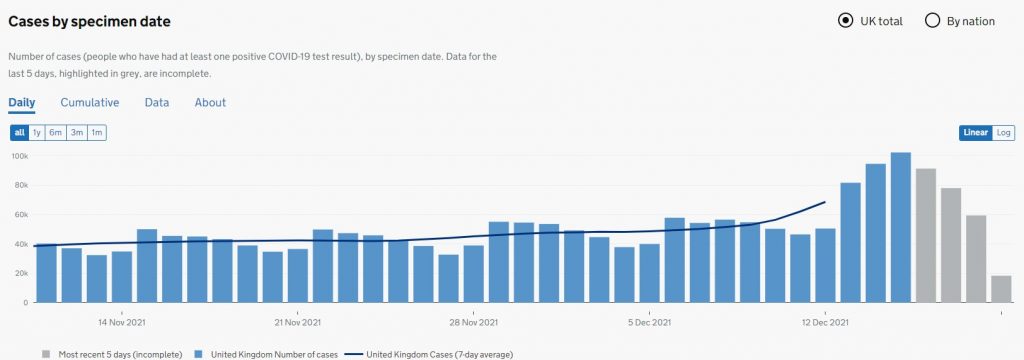
December 15th was 10 days before Christmas. Given that people have to isolate for 10 days if positive, this suggests the peak may be largely an artefact of people getting tested ahead of Christmas. The leap in testing on that day is also indicative of this.

In this regard it is similar to the spike in tests and positives that occurred ahead of the summer break in July. That quickly dropped off as schools broke up and people went off on summer holidays. We may well see a similar phenomenon now that schools have broken up and people go away or to family for Christmas.
Most of the recent spike in positive tests is an artefact of the increase in testing. While the positivity rate in the U.K. saw a modest rise in the past week, up to 5.3% on December 19th from 4.4% on the 14th (see graph at top), it is not yet any higher than it was in October, and far below last winter’s peak of 13.5%. No reason to panic there. Deaths also continue their downward trend. How does data like this warrant the return of draconian ‘last resort’ social restrictions?
Rather than causing a large new epidemic or surge, Omicron appears largely to be replacing Delta for the winter wave – though Delta is still retaining some market share for now.
Meanwhile in the original epicentre of the Omicron outbreak, Gauteng province in South Africa, reported infections have been falling sharply in the past week.
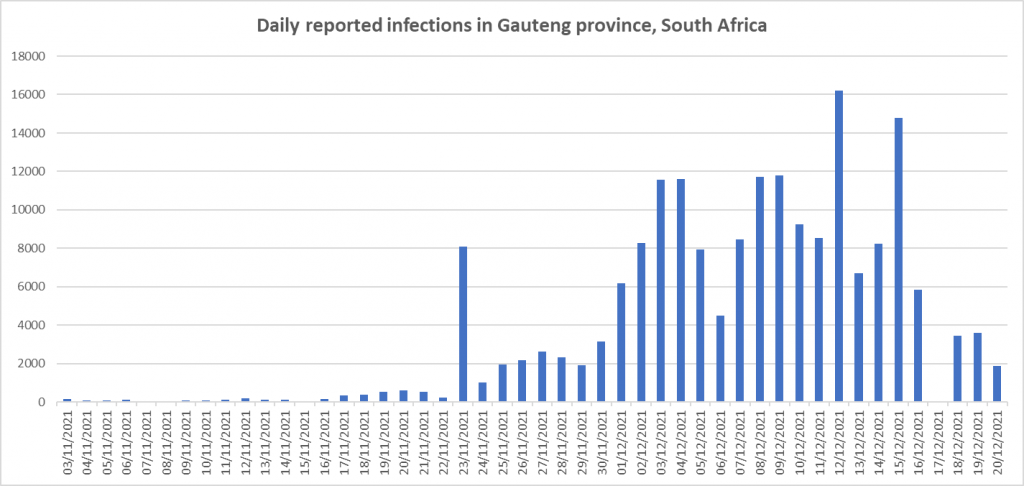
National data from South Africa also continues to show a much milder disease, with ICU admissions currently at 21% of their July peak, or 79% lower.
This mildness has been confirmed by new data from Denmark, which finds the hospitalisation rate from Omicron 60% lower than from other variants.
Perhaps it should not come as a surprise, then, to hear that South Africa’s Ministerial Advisory Committee on COVID-19, which is similar to SAGE, has written to the Health Minister Joe Phaahla recommending that the quarantining of contacts and all contact tracing be halted with immediate effect. It is no longer necessary and too costly for individuals and society for too little benefit, they argue.
We have learned more about the manner in which COVID-19 is spread, and also now have to contend with variants of concern whose epidemiology differs from that of the ancestral strains of SARS-CoV-2.
Crucially, it appears that efforts to eliminate and/or contain the virus are not likely to be successful. Therefore, it is critical that the role of containment efforts like quarantine and contact tracing is re-evaluated.
In addition, among the small proportion of symptomatic cases, testing is far from universal, since patients may not seek testing when their symptoms are mild and when testing would be burdensome and expensive. Furthermore, the SARS-CoV-2 test sensitivity is suboptimal, sometimes leading to false negative results.
The inability of the current testing strategy to identify the bulk of cases is illustrated by the high SARS-CoV-2 seropositivity rates seen across multiple provinces in serosurveys, implying that only a fraction of cases (perhaps one in 10, or even less) are ever diagnosed.
It stands to reason that if the vast majority of cases are not diagnosed, then the vast majority of case contacts are also not diagnosed. This means that quarantining and contact tracing are of negligible public health benefit in the South African setting.
Boris’s support base is collapsing as even once-loyal Ministers desert him over his apparent addiction to lockdown restrictions. Yet he is deaf to their pleas and seems only to have ears for the doom-mongers of SAGE. Government modeller Professor Graham Medley revealed on Saturday they didn’t model more positive outcomes for Omicron because they weren’t asked to. Who didn’t ask them to, and why not? Boris has many enemies, and he is only making his position worse by alienating his natural supporters while heeding the advice and adopting the policies of those who would gladly see him gone.
Time to wise up, Boris, and start listening to the right people. Omicron is not “surging”, and neither is it a cause for panic. You just need to keep calm and carry on.
Stop Press: Tuesday’s reported infection numbers dropped again, to 90,629, and the peak by specimen date remains December 15th.
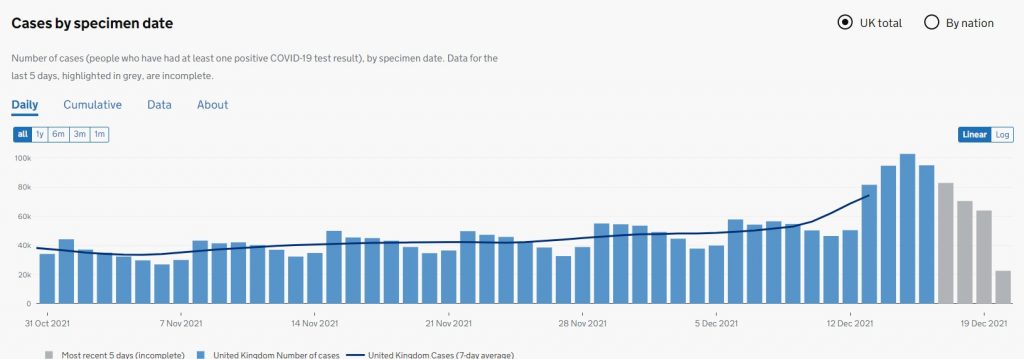
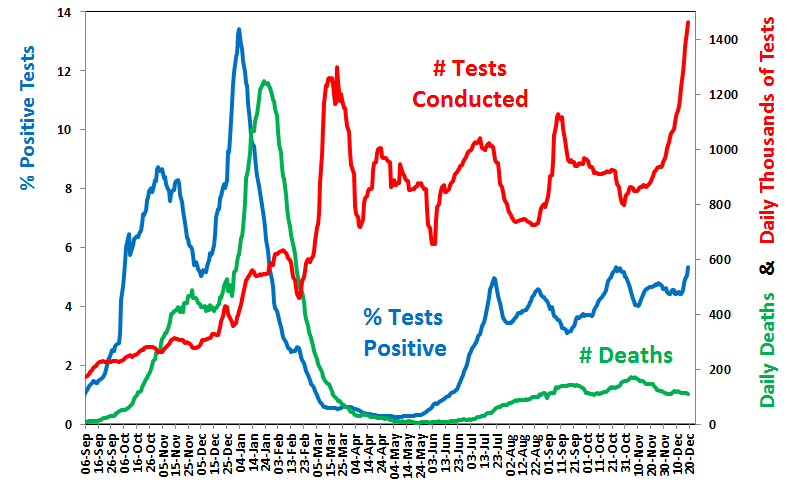
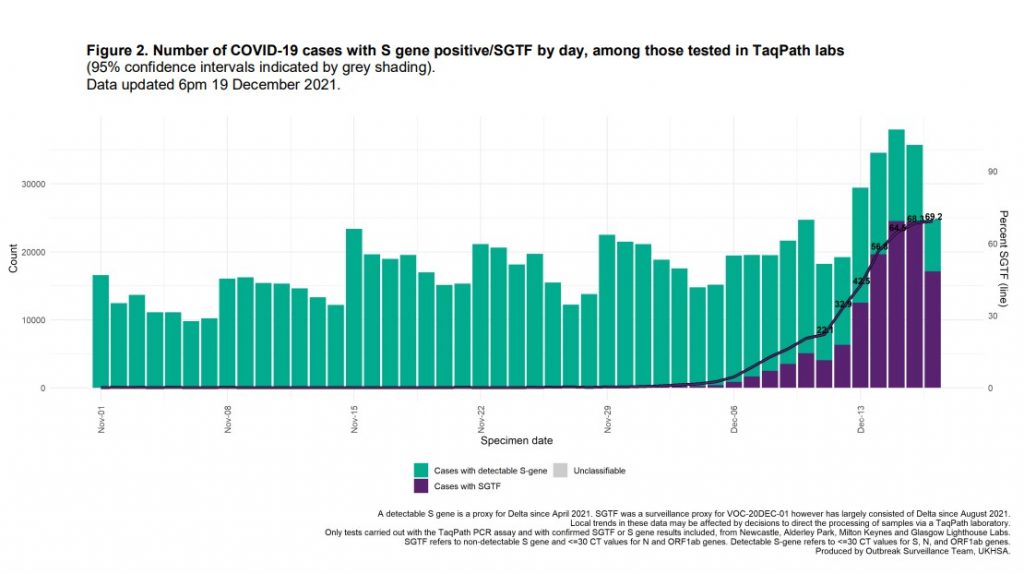













To join in with the discussion please make a donation to The Daily Sceptic.
Profanity and abuse will be removed and may lead to a permanent ban.
No surge in Omicron. Just a nationwide surge in cognitive dissonance as Boo Radley and the Great Pumpkin, stalk the land.
Every aspect of Johnson’s character and behaviour shows weakness and cowardice. His only and overriding concern is him, and leadership is absent. The epitome of a congenital liar, he listens only to potential scapegoats for his own failures.
Well described . He also has an agenda joined at the hip to his family friend Bill Gates.
It’s a pandemic of testing for a virus with mild common cold like symptoms.
The general public need to get a grip.
It’s a criminal conspiracy, is what it is.
Various Court actions now launched claim exactly that – with a mountain of evidence aimed at named individuals.
What an acid test this will be for the integrity of our legal system.
I’m sure our legal system will fail its duty.
I think it is unfair to blame the general public in the face of the unprecedented government promoted media blitz of misinformation.
No. We shouldn’t apologise for those many people who are too naive, short-sighted and unimaginative to see the truth which is in clear view. Their compliance condemns us all!
They’re bedwetters.
Or chinwobblers…
Nearly over now. They just have to keep the terror going a little longer until Putin invades Ukraine.
Be careful what you wish for, they’ll probably make all vaccines compulsory in case Vlad threatens biowar on us!
Well, at least it won’t be a surprise attack.
We are more likely to see a False Flag chemical attack sponsored by the CIA.
What is it with this line I keep hearing from government: “We reserve the right to . . . “
No – you have no rights over me or anyone else to do as you please. 🖕
Yes I find that as egregious as you, I notice that started early on, beware any politician that starts a statement with, “it’s only right” (a Blairism) or it’s “our right” I’m not sure the state has any rights at all.
Apparently governance over us is consensual, though I’ve never seen a copy of the social contract or signed the policing consent form.
Hello Anti,
As you are numero Uno on here, I wonder if you have time to pop over to the Conservative Treehouse and have a read of their article on a Swedish outfit marketing a little implant on your hand .
This will allow ‘them’ to automatically track you – awake or asleep and control you like a sheep!
Frightening does not describe it.
Thank you for your great contribution non here and a happy Christmas
Quite right. You can only ‘reserve’ rights that you already have, but it is highly questionable whether government ever had the right to do all the things that they do.That’s why judicial review is so important – to show that government diktat and policy are unlawful.
Unfortunately, many politicians think that there is nothing that they cannot control: their power is fully extensive. That is not the case: there are many other governments, not least in the family and the church, which are not subject to an overriding executive government. However, executive government always has coercive force at its disposal to get its own way, but that does not make it right: it makes it repressive, tyrannical, and certainly totalitarian.
Also, when governments sign treaties they may reserve the right to get out of treaty obligations by getting out of a treaty, but while they remain signatories they cannot reserve rights to act contrary to the obligations.
This government is riding roughshod over all manner of rights and obligations. Why is there such a deafening silence from those who champion the rights of those overseas?
‘Reserves the possibility…’
So Lord Tyrannus is not even saying he has the right to coerce, just the permanent opportunity!
Arbitrary power in the hands of a lost contrarian.
and if you’d sourced from ZeroHedge instead of your mate’s rag you’d find Denmark and the detailed stats around vaccine failure.
https://www.zerohedge.com/covid-19/stunning-covid-data-denmark-not-reason-youve-been-told
I wonder how many of these terrorised mongs getting “tested” right now intend to self intern themselves once they get the positive result that they so desperately desire.
Seems to me that it’s more about getting the week off, while signalling on social media that they’ve been good citizens and have loyally caught the inevitably fatal disease. Pray 4 them, soon to be fliing hi wit de angles.
But you’ve got to have your Christmas, don’t you?
Was talking to some colleagues at work yesterday – only a handful going to one of the christmas parties because the rest don’t want to risk having to ‘isolate’ over christmas. What is wrong with people? It’s quite simple – don’t take any tests. People are so compliant…
The real problem is if you want to travel. There you have to take a test and the elephant in the room now with the ‘you must buy an expensive day 2 PCR from our cronies’ means anyone who has actually had covid in the last 90 days is likely to test positive and thus have to isolate. Current sensible advice is, book test and unfortunately pay for it, but don’t take it.
Yes, fair enough – but in this case none of them are planning to go abroad!
“People are so compliant” I’ve just said exactly the same thing to my husband !
We just cannot understand the sheep mentality of some people, particularly those we have always considered fairly intelligent. It’s quite baffling….
They’re not Angles but angels…
Those rushing to get “tested” for evert sniffle are the reason we are still in this nightmare mess!
Classic comment from presenter on Talkradio this morning. A summary:
Presenter: ITU is full of people with Covid who are unvaccinated
Caller: Were they tested after going into hospital for something else?
Presenter: They all had a PCR test.
Caller: The PCR test is not fit for purpose because the inventor said so.
Presenter:Well I listen to real experts who tell me it is. The lateral flow test (my italics) has a specificity of 99.9%, but I am not going to let you talk any more because I’ve had a vaccine and it didn’t affect me.
Edit: it was just before 8am if anyone wants to listen
Do you expect anything else from James Max.
Speaking of Talkradio or Talksport (are they the same?) the other week when yet another young fit footballer collapsed clutching his chest, an ex footballer asked on air if he had been jabbed.
Guess what – his feed was immediately cut.
Here you go….Trevor Sinclair commits the cardinal sin of asking whether John Fleck’s collapse is due to the vax. Cue instant suspension of Talksport broadcast and its removal from their archive
https://twitter.com/i/status/1463895924925771779
I heard this too. Haven’t heard the presenter before and will avoid him in future.
They’ve lost a listener.
Thanks for that – I think I shall give it a miss!
LFT results don’t stand on their own, they need confirmation from the other fake test to be taken seriously.
I’ve seen the queues of cars at a regional test centre and a local pop-up for several days now.
I imagine they are the recently “vaccinated” who have been told to get a test.
What a surprise – not!
I have no time for Boris, and hope that Will is right, but:
It is a fallacy to measure the trend in cases by just looking at one or two days – there is a weekly pattern (lower reported cases on Sundays and Mondays) and also quite a variation in single days. You really have to look at the 7 day moving average and that shows strong growth. We may have peaked- you can never know – but there is precious little evidence in the current data.
As I have pointed out elsewhere, just because the tests go up, and the positivity ratio doesn’t change much, it doesn’t follow that “Most of the recent spike in positive tests is an artefact of the increase in testing. ” It all depends on why the testing has increased. If more people are testing because they have symptoms, or have been exposed, then it is the increase in cases that is driving the increase in testing.
You can’t compare South Africa or Gauteng province to the UK. Different demographics (much younger), different climate (it is summer there), different health service and so on.
As we all know, deaths, are a lagging indicator. We shouldn’t expect to see any increase in deaths until after Christmas. Hospitalisations also lag a little. However, have begun to rise in London where the Omicron variant first took hold. https://data.london.gov.uk/dataset/coronavirus–covid-19–cases
On the whole, I suggest it is too early to see how this is going to pan out.
“I suggest it is too early to see how this is going to pan out.” Au contraire, that was basically known at the time of the Diamond Princess. Covid is not exceptional, get back to normal now, move on. Or, if you prefer, you can stay at home, get vaccinated as many times as you want, wear triple masks for the rest of your life, and leave rational, alive human beings like me and my family to get on with our lives.
I’m no mathematician. I’m a retired fireman, but saw a thing on Youtube about Benford’s Law and its application by forensic accountants to help detect fraud.
Could it be, or has it been applied to the daily figures on infections, hospitalisations or deaths.
Somebody else pointed out the new ‘surge’ in positive cases started on Dec 13th, exactly when Pig Dictator instructed the obedient horde to rush out and boost like their lives depended on it.
Fresh surge of s1 spike protein bio-weapon.
I’ve been tracking the UK Mortality stats on the Government’s ONS site: (https://www.ons.gov.uk/peoplepopulationandcommunity/birthsdeathsandmarriages/deaths/datasets/weeklyprovisionalfiguresondeathsregisteredinenglandandwales)
Below are the deaths for 2020 and 2021 for:
The latest weeks of 2021 are tracking materially higher than a) the same period in 2020 and b) at any time in the last 24 months.
Yet more useless gatekeeping.
So what if ‘cases’ are ‘surging’. No one dies from it, yet ‘everybody’ gets it. That is a good indocator it is endemic.
What are the symptoms (I know, so pre-New Normal) of this endemic disease?
According to reports of COVID-19 patients from London, the most common symptoms of omicron are a runny nose, headache, fatigue, frequent sneezing, and a sore throat.
That sounds pretty familiar. What to call it? It is so common everyone gets it, and it happens when the weather starts getting cold.
How about Common Cold?
Meanwhile Knight of the Realm, ex-sage and well-known killjoy Sir J.Farrar reported by the British Propaganda Corporation as saying “Omicron transmission eye-wateringly high.”
God save us from the BPC and these ghouls, goblins and garden gnomes.
BBC Scotland online interesting today. As we get softened up for a ban on outdoor events, the contempt for Sturgeon and her dissembling advisers is palpable. Dentist of Doom Jason Leitch (who calls himself Prof, through an honorary degree given to him by a University sucking up to a top health powerbroker) was asked (incredibly), a real question. What’s the level of hospitalisation and death? Surprisingly he had no figures to hand but said it’s too early to tell. Many commenters mentioned that. They also mentioned Fraser Nelson’s exposure of SAGEs bad scenario only modelling. Not just the usual unionist but many pissed of SNP voters too. Generally a lot of contempt for Sturgeon and her attempt to back up Drakeula in pushing the panic button. A growing awareness among Indy supporters that it’s a delaying tactic. Only the media are keeping her at the forefront.
I need a booster that doesn’t protect me, because the first two jabs don’t protect me.
Simples!
Ivermectin help reduce the severity of vaccine adverse reactions. If someone is suffering from a post vaccine syndrome, FLCCC clinicians and a growing network of colleagues have reported significant clinical responses to ivermectin. Because Ivermectin has 5 different mechanisms of action against coronaviruses, the medication is also effective with the different variants of the virus. Get your Ivermectin while you still can! https://ivmpharmacy.com
The PCR test has been exposed as a total fraud by Reiner Fuellmich for over a year – and yet media silence and misrepresentation of ‘positive’ (97% false) test results as ‘cases’ have allowed the fraud to continue to our great cost . To end the pandemic we need only to stop the fraudulent PCR tests.
This is a PCR/ Media scamdemic
You cannot use All England or All UK positive tests to measure the epidemic because there are two epidemics running at the same time. The Delta epidemic in the West Country and North West is still declining and this is offsetting the increase positivity in the Greater London and M1 Corridor. You have to report by areas. The Positivity Rate in Scotland is about 15 percent. There is also the well documented tendency of positives to increase shortly after vaccination, and for vaccinations to be ineffective for about 20 days after vaccination. Really, the Do Nothing Option would take the sting out of this.
How are they testing for Omicron? Can they? Can they do it at this volume given they need to do follow up tests to the PCR/LFT? Or, is it all one big lie. I know where my money is, and has been since April 2020.